|
|
Post by swede70 on Nov 6, 2015 12:25:30 GMT -8
Greetings and first thread post here...
It is my hope to create two '70 season Penske Racing Javelin Trans-Am cars, one being the first Donohue entry with the earlier spec. cage and seat (among other details), as well as a late-season entry with the taller NASCAR rear tires, Racemark seat, as well as other sundry details that distinguish it from the other model. Both are based upon the ubiquitous Jo-Han tool combined with a pair of old Jimmy Flintstone flared fender/quarter panel T/A Javelin bodies. Some elements discernible here and there have been used as masters for select hand cast resin efforts and thus constitute stuff I can reproduce without great effort, so know this too. I expect the late-season model to be a bit more complex than the early-season effort, whereas both are ambitious given my limited experience with multi-hued paint finishes in particular. Just pondering matters, isn't it nice to have a virtual Motor Racing Replica News of a sort available and at the ready?
Hope exists to have these projects ready for the 50th Anniversary of the SCCA Trans-Am in 2016, something that informs the themes of select contests held next year. My intent is to have both ready to go come the Sylvania, OH show (i.e. the old Maumee, OH show) and the Macomb Community College contest/show (this held in southeast Michigan) that follows hard upon it late in the year. My goal is to at least have one or the other selected for an inset photograph to show up in the annual Scale Auto Contest publication; i.e. such would satisfy. I'll try within the space of this thread to toss off ideas and part combination discoveries which seem to work and might help better inform 'grail projects' such as I've pursued my own up to this point. Thanks for choosing to follow along...

...this would be the late season car mocked up, with hard resin tires fated to be cast in a flexible material tinted black.
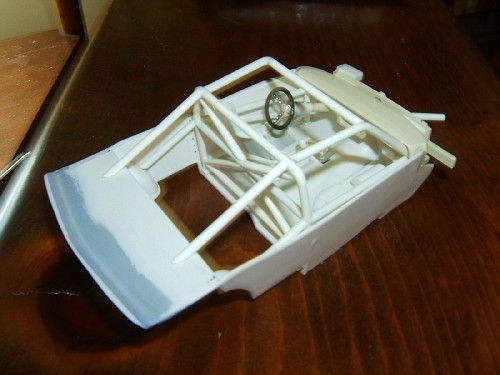
...this would be the late-season interior missing a few tubes. The cage is scratch built from plastic tube and brass wire.
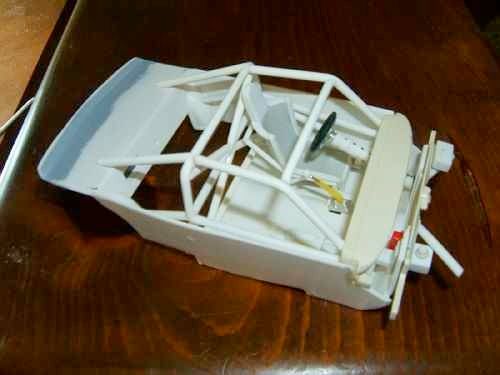
...this would be the same interior showing the built up Racemark seat with the extended leg support section shown to better effect.
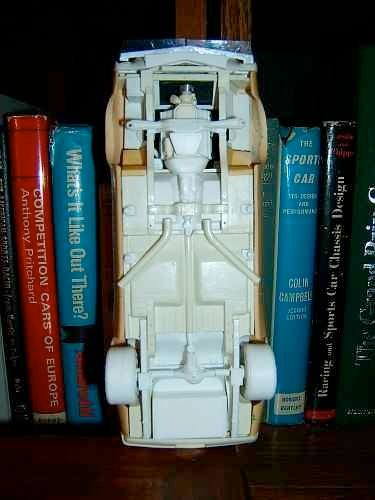
...this would be the late-season entry revealing an SC/Rambler rear axle hump substituted in, a pair of like-sourced SC/Rambler shock mounts added atop a pair of leaf springs (also Jo-Han SC/Rambler pieces) overlaid onto scrubbed cast-in Jo-Han Javelin springs. Also made out will be the Jo-Han Rebel Machine front cross member and lower control arms, plus inner fender detail that certainly isn't final. Note the four scratch built jacking points added just forward of the exhaust dumps. SC/Rambler driveshaft ends plus U-joint detail has been blended to the existing substandard cast-in driveshaft provided, but at least it matches and is 'all in the family' for blending nicely. Track bar, sway bars and other details are to come.
The rear tires are slightly widened MPC Goodyear Blue Streak Stock Car Specials, while the unseen fronts combine sidewall detail from much older MPC Blue Streak Sports Car Specials with reduced in diameter 'tread' (rather just select indentations on a pattern' stolen from hollow vinyl versions trimmed to diameter, and then cut and cast. The AMC Model 20 differential introduced here is a from an ancient Jo-Han Hornet or Javelin funny car kit release and is something I've cast up and can provide others if desired.
The other earlier Javelin will have a less elaborate front seat, turned aluminum outer rims akin to what was used at Bryar, NH and Mid-Ohio (at the least), and will be photographed soon consistent with my reengaging this ongoing project. Much revised SC/Rambler inner fenders will be done up to introduce to both of the builds, whereas I hope I can come up with something better than the same bits unmodified and/or the unrevised '70 Rebel Machine items blurrily witnessed in these old photographs. I appreciate others looking in and thank you for your time. Kind regards to the community...
Mike K.
|
|
|
|
Post by afx on Nov 7, 2015 4:17:21 GMT -8
Looking forward to this project Mike. I have the JF resin body in the stash.
|
|
|
|
Post by crazyed on Nov 7, 2015 6:11:55 GMT -8
Mike, Given the Builds background partner I'm guessing you are also a fan of the Donohue/Penske team from back when! So You're going to be building Both the early And Late season versions of the '70 Javelin! I bow not only to your taste and Skill as I watch this progress, but your Stash! You've got 2 of these Kits?........... Wow. Now along the same thought stream but changing the specific subject - Which 917/30 is that in the background, Model Factory Hero, Fisher of Umi, and did you happen to take WIP shots of it?
|
|
|
|
Post by swede70 on Nov 9, 2015 10:42:39 GMT -8
Greetings and thanks for viewing my material,
Actually I'm something of a later-generation Mark Donohue fan having only discovered his story via period magazines collected plus a suitably early read of The Unfair Advantage from a local library. Most of the period magazines (about 1,400) were gathered on bicycle from antique and used book stores when I was younger, whereas the intense/depressive/academic/slight outsider status of Donohue immediately appealed. As might be picked up from my writing, I often feel the same way. Yes and indeed - I've collected period motor racing books and associated swag since my middle teens, and hence I have a great many neat things I treasure. I'm 46 y.o.a. as I type this...
As for the 917-30, it's actually a prefinished Minichamps diecast in 1:18th - hence no great personal talent on show then. The image constitutes a very old photo, although it looks so evocative that I felt that it would be appropriate to start matters out for discreetly employing such here. The smaller Donohue Javelin picture is an older Sun Oil Co. promotional item picked up on eBay, the postcard being a Ronnie Kaplan Engineering/'69 AMC postcard also sourced via the 'Bay.
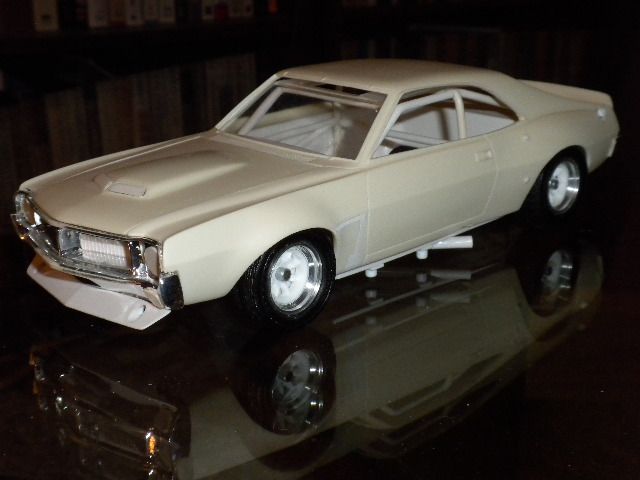
...this would be the other and earlier Penske Javelin spoken of above. The roll cage is clearly inadequate as-delivered, hence I'll swap such out for something constructed along the lines of what is situated in the second build. The tires are Perry's Resin Goodyears likely reproducing the fitment found in the Monogram L88 Owens-Corning A production Corvette kit. The Minilites are resin clones of the original Jo-Han parts plus the addition of hub guides fashioned from the usual aluminum tubing. These guides will be painted a suitable gray given Penske Teflon coated such.
The outer rims with the nice taper are obsolete MPB Designs DM 3153 Billet Aluminum Wheels cut down to size to leave only the outer lip. The 'normal' Minilites employed on the late-season car combine Jo-Han Minilite centers with MPC Chrysler Kit Car pressed steel wheel outer lips with two unmachined pads added to the inside lip to reflect air valve installation points unused on a period Trans Am racer. Close contact endangered air valves to risk of damage, hence the valves were relocated between the spokes. At first I tried to place tiny wafers of material atop the inside lip of each wheel, but found control of such difficult. Finally I drilled two holes 180 degrees apart and pulled through a length of round plastic stock which proved far easier to finish...
Moving on to other things, I thought I'd screwed up this body for good given I too aggressively carved out the front wheel arch and effectively lost the contour otherwise there, although now it can be noticed that I've introduced a patch panel from yet another JF shell to make matters right. Just to mix things up, contrast this picture with the last on this post to pick up the worth of fabricating a better cage from scratch. Sure to confuse, the last image shows the later interior with an early-season spoiler and too tiny tires.
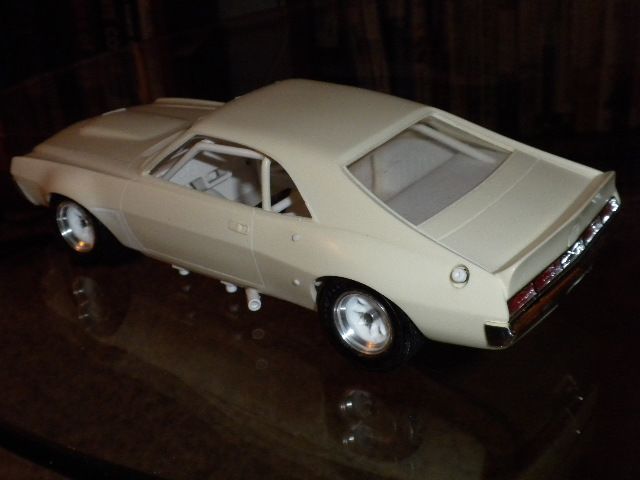
...same model, same nice taper on the machined outer wheel lips. The fueling inlet is set higher than on the standard Jo-Han shell and was drilled by me given it doesn't feature on the JF shell. Somewhat barbarous to relate, the same JF shell sacrificed to correct the wheel arch opening contour of the model also gave small sections of panel work to build up the back area of the fueling inlets on each side; i.e. the panel beneath each port matches for contour what is seen above given it's the same panel casting visible again. A discreet plug can be seen situated within the base of the rearmost surface of the rear spoiler, whereas a set of jacking points (four in all) also can be made out.
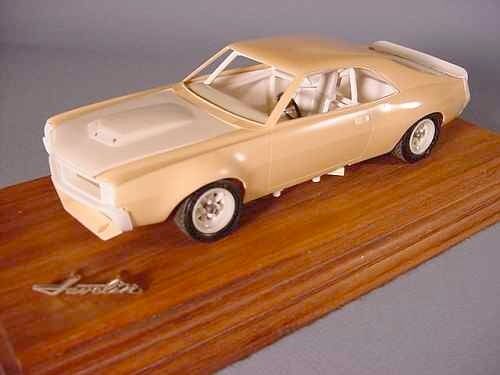
...something of a confusing cheat, this is a mock up of what will be the first model with the later cage. Hard to see, but notice I've cut out the flush door handles and rendered them separate parts to better facilitate chroming and/or selective refinishing. I didn't want them to appear blobular under coats of paint and foil, and hence off they came. The tires here are too tiny and were tossed aside rather immediately after this photo was taken, although the individually set lugs (four each wheel then) can be made out. Detail of the later-season front spoiler and revised rear spoiler are to come where I've match the later '71 and on spoiler ends that dip down with the center section of the '70 model spoiler. Discreet little additions help. Thanks for skimming this post.
Mike K.
|
|
|
|
Post by swede70 on Nov 11, 2015 15:15:09 GMT -8
Greetings and thanks for the kind notice,
Other details with mild additions noted...
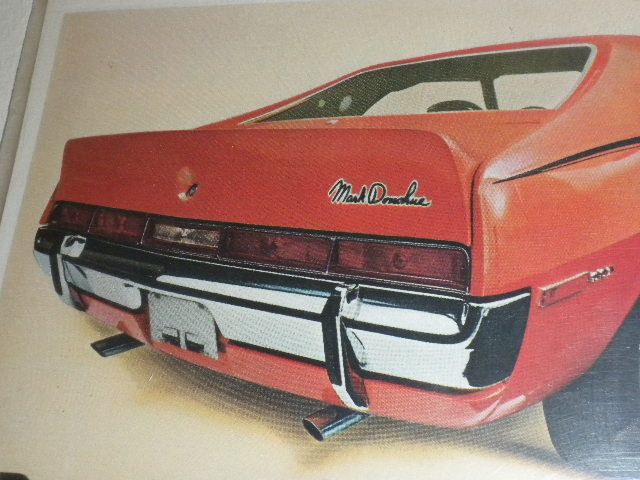
...Donohue puts his mark on the Javelin. Note the tiny dips at each respective end of the namesake spoiler...
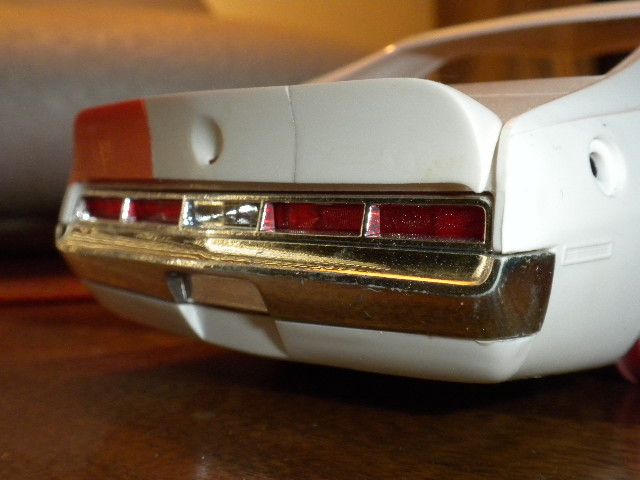
...me putting my respective mark on a scale Javelin. A bit crude as a mock up less 'dip' reduction and blending, but at least I have a shape to work with. The early season car seems to have been run with a spoiler less the lock cylinder cut out, whereas the late-season design is different again for the fuel inlet finding a home in the bottom center (photo image to come). Yes - a homologation special stock example will eventually be done, albeit not immediately.

...what one essentially starts with less grille insert. The Jo-Han Donohue racer release happily comes less the 'JAVELIN' cast-in license plate up front a per the promotional model as well. The Jim Paschal NASCAR GT/stock kit release has the less desirable 'JAVELIN' license plate front bumper/grille assembly within, so try to steer clear of such or at least be away of the worth of the 'plateless' option. All the same, Jo-Ha made no effort in period to open up the area beneath the license plate area as indistinctly made out here.
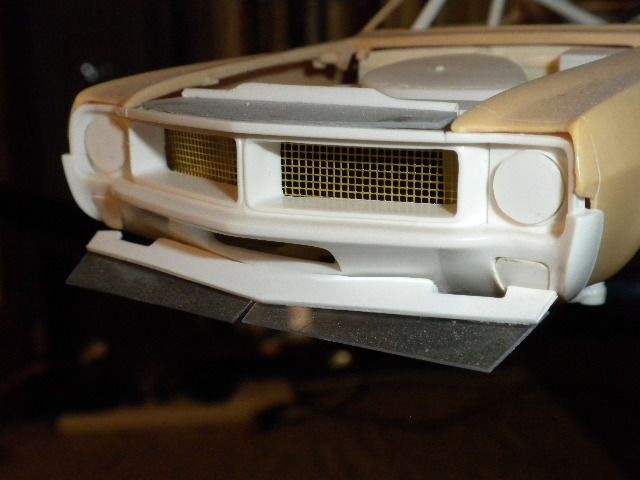
...a few things visible then. Headlamp mounts aren't flush - though I might change this. Any period team would want them situated as far forward as possible in all likelihood. Note the late season spoiler taking shape, the brass mesh grille, as well as the opening made beneath the center tip of the bumper which in truth calls out for a further brass mesh screen at the very least. The body displays slight warpage that needs to be addressed, whereas I intend to add material to the fenders just atop the bumper ends to fill that nasty gap. I'll likely cut up the spare body still further and use material from each opposite fender mounted upside down to bring matters under control here. Lastly, the front turn signal indicator plugs as provided in the Donohue '70 kit have been worked over considerably so that they'll sit about flush with the surface of the bumper.

...some of the under hood panel work on view. The radiator is a Monogram stock car unit mounted rather like a Corvette for being angled in. Such slips out like a suitcase, whereas again I'm not thrilled with my inner fenders, etc. and thus I intend to rebuild what is witnessed here. It helps to find comprehensively documented restorations accessible online for good 'engine out' photographs and more. Know that the air cleaner is scratch built, the cylinder heads are SC/Rambler items, while everything is lightly glued simply to ensure all that is constructed lives in happy collective proximity. And oh yes - etching the panel gap between the fender trim ends and each respective fender is no fun at all. I cut out the same on the back of the late-season car and substituted in clones carried away from the aforementioned spare resin shell, and while it will have an opening trunk with associated detail, the early-season version will not.
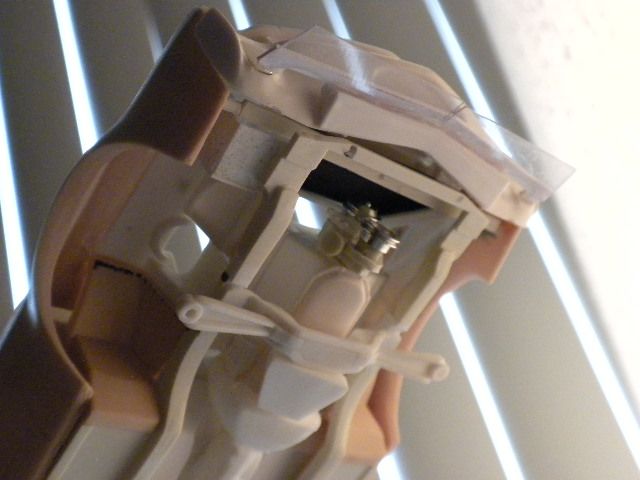
...beneath the front of the late-season car. Note how the awful axle locating blobular mass 'o plastic has been removed entire, with the frame rails rebuilt upon the removal of such. Jo-Han Rebel Machines (and likely all Marlin kits) come with a complete front suspension, whereas I hope to build upon this. The angularly set radiator can be seen again, while note too the destined to vanish beneath paint turned aluminum pulleys. The early Aviad pan will be swapped onto the early car, while I intend to build up a late-season Aviad design wet sump to replace what is seen here. The scatter shield is scratch built and not quite finished. The basic oil pan come from an early release of the Jo-Han Javelin range and differs from later releases for having visible hardware detail. Brake duct work will come in time, although the top surface of most of them seems to be made up of the contour of the bumper itself.
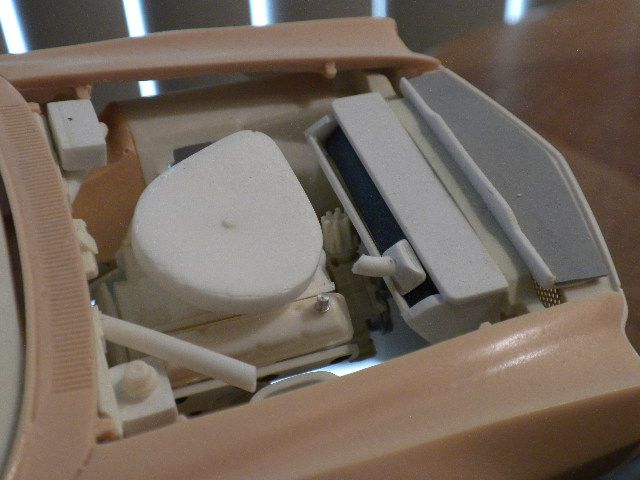
...some material has been rendered too thick and requires thinning, but matters viewed from the top and forward then. I hope to use some flexible straws filled with clay and bent to suit for the intake ductwork collecting air from the perforated radiator support, cast the same in resin, and then file to fit. Thanks for skimming this update.
Mike K.
|
|
|
|
Post by dustymojave on May 10, 2017 18:47:52 GMT -8
Has there been any progress on this project? Having worked on restoring one of the Penske71/RoyWoods72 Javelins 2 times, I find this build interesting. I had hoped to see it go on. 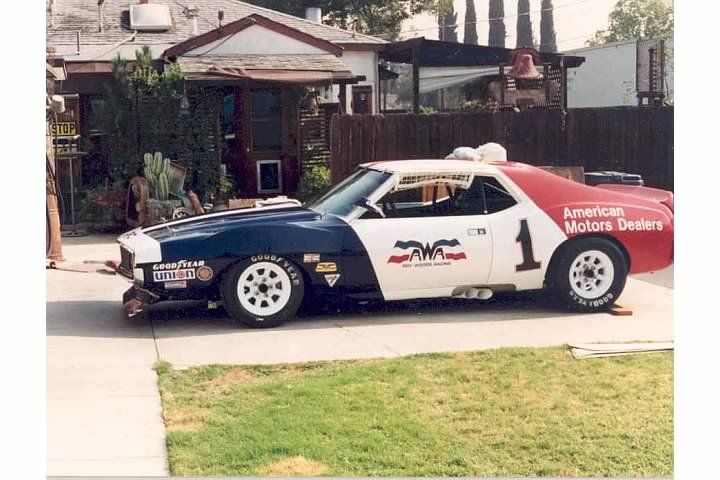 Some reference views of things like engine bay less engine are available. 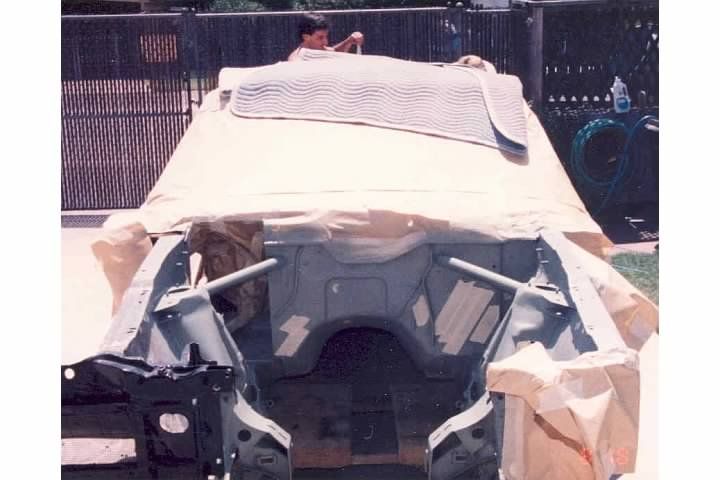 Or with engine: 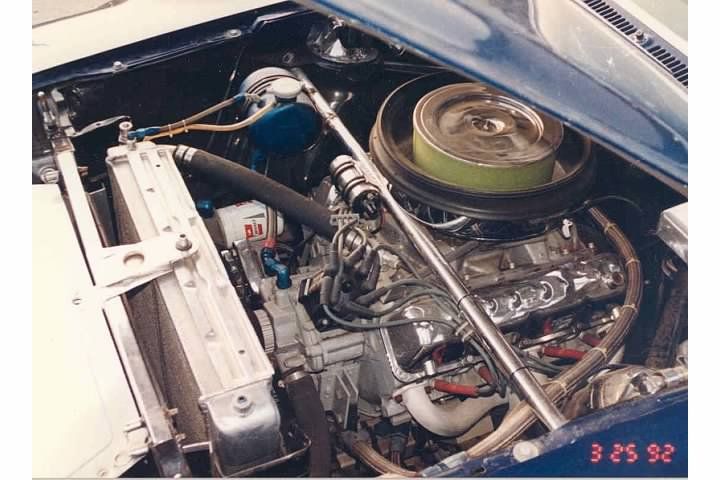 |
|
|
|
Post by swede70 on Jun 25, 2018 15:09:28 GMT -8
Greetings,
Very tardy by way of reply - yes, the 1:25th JoHan Javelin projects still exist even as they haven't been 'front burner' for some time. Thank you for the nice engine out image of the car which is much appreciated. With the restructuring of the Photobucket fee scale I hope to return to various boards including this one, and hence anticipate seeing further posts consistent with sharing ideas and resources as they are availed. Kind thanks...
Mike K./Swede70
|
|
|
|
Post by afx on Jun 26, 2018 3:52:22 GMT -8
Hope these builds move to the front burner soon Mike.
|
|
|
|
Post by dustymojave on Jul 5, 2018 16:42:49 GMT -8
I wish now that I had taken the time to take a lot more photos of the various race cars I worked on over the years.
In restoring that 71-72 Javelin, I was working with a man who had been a crew member at Roy Woods Racing when that Javelin was there, and we had help and advice from the man who was the crew chief for Roy Woods Racing. I learned in that process that one of the 71-72 Penske/Woods Javelins had originally been a 1970 Penske Javelin. I don't recall anymore which one of those 71-72 Javelins was the '70. At the end of the '71 season after winning the Championship, Penske sold the Javelins and all spares to Roy Woods Racing. Woods put George Follmer in the driver's seat who took it to another Championship. I believe there were 3 cars in that change-over from Penske to Woods. That car I worked on is now owned by Ken Epsman, who for a long time owned, and maybe still does, the Sam Posey Dodge Challenger. I note the blue paint is now looking much lighter and seems close to the Sunoco blue it wore when it was a Penske car. The Woods blue should be pretty dark. But that doesn't apply to your 1970 Javelin model.
I've discussed it elsewhere on this site, but I learned that many restorations of vintage race cars are not done any thing close to how the car was when it was originally raced. Not only are there developments as the car is used in competition, but often those who own the cars now were not around when the car was being raced and often want the car to be built as modern race cars are built. So I want to caution you about using restorations of vintage race cars for reference.
|
|
|
|
Post by Oldtimer on Jul 5, 2018 16:52:35 GMT -8
I've discussed it elsewhere on this site, but I learned that many restorations of vintage race cars are not done any thing close to how the car was when it was originally raced. Not only are there developments as the car is used in competition, but often those who own the cars now were not around when the car was being raced and often want the car to be built as modern race cars are built. So I want to caution you about using restorations of vintage race cars for reference. Unfortunately, the diecast manufacturers both haven't figured that out, as well as not figuring out that when you start with a basic mold that was a streeter, you need to strip off the non-racer stuff. |
|
|
|
Post by swede70 on Mar 2, 2021 9:11:14 GMT -8
Greetings... For sorting through some older Jo-Han Javelin materials and further, for sourcing some bare Trans-Am chassis and interior parts via period kit eBay sellers, two projects were revived in recent days. One would be my early season '70 Penske Javelin, the second, a 'new' '71 Penske Javelin for fairly rapid, albeit productive application. It's a good thing I'm a vampire and can stretch my scale efforts across decades lest there would be no hope at all for me.  This would be Mark Donohue descending the Corkscrew at Laguna Seca at the first SCCA Trans-Am event held in '70. Dealers complained to AMC that they needed a more aggressive front end, a hood scoop, and a more appealing dashboard design with faux wood to lure buyers looking forward, hence the facelifted '70 received each of these features.  Seen with the wheels and tires swapped out again, a new tighter fitting roll cage missing all the smaller bars, brass exhaust dumps, jacking points, rear screen retention straps, etc. The Jimmy Flintstone '70 Penske Javelin Trans-Am shell is intended to replicate a late-season entry with refueling through the back near the base of the rear ducktail spoiler, while here I've backdated things for cutting refueling ports through each respective quarter panel. At least for resiting the ports on this resin shell, such could be set higher than on the standard as-delivered Jo-Han Trans-Am Javelin body.  Tires are just standard Jo-Han/AMT NASCAR issue of old up front and seem good enough. The rear tires are Southern Motorsports 1960's Goodyear NASCAR issue which have nice sidewall detail and also afford the buyer very nice Yesterday's Decals Goodyear Blue Streak blue lines and small, controlled Goodyear tire sidewall lettering suitable for an early season scale replica. The hub guides are just trimmed aluminum tube, the wheels, home brewed resin copies of Jo-Han Minilites with MPC Chrysler Kit Car Clement five slot pressed steel wheels which afford tapered outer lip detail otherwise missing on the Jo-Han renditions.  Above would be seen a patch worked in to render the refueling port situated along the base of the rear spoiler invisible given this is intended to be an early season effort. The standard Jo-Han kit tail light lense insert appears a bit pale and pinkish here, hence it'll be stripped and redone with a darker red tint. The Grant steering wheel is a Jo-Han Hurst SS/AMX item (being chromed), with the spokes shortened, and finally, a rubber bathroom washer hardware gasket employed as a rim.  Barbaric as it sounds, another Jimmy Flintstone shell was used to perform a few things here including a doubling up of the curved profile beneath the refueling port/cap seen here (a section of the same panel is stacked from behind to replicate the curved surface from behind then), while the front wheel arch trailing edge and the rear spoiler base each needed a patch if I was to press ahead. Thanks for your review of this my '70 Penske Javelin project. Mike K./Swede70 |
|
|
|
Post by swede70 on Mar 2, 2021 9:31:41 GMT -8
...while this would be a brief rundown of my recently worked up '71 Penske Javelin effort, based mostly on massaged kit parts,  Dave Friedman image Seen at the first event on the '71 Trans-Am season calendar held at Lime Rock, CT., notice the odd wheel arch opening profiles that stretch upward towards the character line both front and rear. The rear arch opening is slightly squared off, the top edge just mirrors the character line, while the front arch opening profile cut slightly atop said character line and expands a bit along the base, and towards the nose especially. Introduced late-season in '70, the tall profile NASCAR rear tires were carried over into the '71 season, having become standard.  Just a few days of work then, but looking fairly credible. All identification in the form of 'AMX', 'Javelin', and '401' has been scrubbed off, while the raised trim along the rocker panels too has been removed after first protecting the body higher up with a length of masking tape. Just a sanding stick was used, although a scruffy one with hardly any life left in it. At least the relative ineffectiveness of the old sanding media slowed me down, reducing risk of damaging things thereby. Photo etched screens cover the headlamp fill panels at this point (soon to be hollowed out), while the front spoiler is just a shape exercise in anticipation of using clear material at some later point.  One can better glean how the scrubbed up rocker panels help the look of this model here, while the front and rear wheel arch openings telegraph better too. Notice the elongated exhaust dump cut outs given they were twinned in '71 and found on both sides. All Jo-Han/AMT Trans-Am Javelin kit releases come through with '70 interiors plus dash, hence here I've substituted in a '71-'74 model consistent with making amends.  Not really happy with the size of the usual rear tire choice in the form of old MPC NASCAR/Winston Cup Goodyear Blue Streak Stock Car Specials, what was used instead are AMT Penske Matador tires essentially doing the same thing. The shell is a restoration piece from an old built up, while glue burns were restricted to the spots where the rear screen retention straps contact the trim surrounding the plastic 'glass'. Happily the body cleaned up very well, hence enthusiasm born of that experience carried over to include what work was performed here. Thanks for your review of this '71 Penske Javelin project. Mike K./Swede70 |
|
|
|
Post by afx on Mar 2, 2021 9:52:47 GMT -8
Always enjoy your projects Mike.
|
|
darylh
Full Time Ride
  
Posts: 126
|
Post by darylh on Mar 5, 2021 16:09:27 GMT -8
I sat in the stands at MIS with my Dad and watched Mark Donohue clinch the '71 title
|
|
|
|
Post by swede70 on Mar 10, 2021 20:05:00 GMT -8
Thanks for the kind notice... This would be another Trans-Am Javelin roughly assembled from parts on hand, it being an intended '72 Roy Woods Racing factory-backed mount. A few months ago I picked up a box-damaged AMT '71 Penske Donohue Javelin for about $70, while at present my '71 Penske effort is actually my '72 Geo. Follmer release, with this '72 RWR Javelin being based on the earlier AMT-badged '71 kit. Related to the reader in confidence, tell no one of this fact! Unless something compels me to do a factory-blessed independent '71-model (or rather a reskinned '70 Penske Javelin) ARA car, this will likely be it for my range of slowly evolving Javelin Trans-Am projects...  ...a low-resolution scan of a press kit image this.  ...while not looking much different as compared to my '71 Penske Donohue effort, with changes restricted to the wheel arch opening profiles and the single exhaust dump cut outs visible along the rocker panels. While dual exhaust dumps were fitted to the RWR '72-season Javelins, higher up the single exhaust dump tunnels apparently remained. A second '71-'74 standard Javelin/AMX dashboard was sourced from a stock kit, hence it's white here rather than orange as seen earlier. Limited though it was, all work performed on the '71 Penske Donohue kit was reproduced across this '72 example. Soon I'll refinish the wheels of both the '71 and '72-season cars consistent with keeping them sorted for both myself and whomever should visit this thread. Thanks for your review of this post. Mike K./Swede70 |
|































